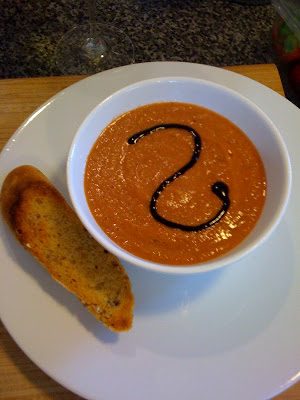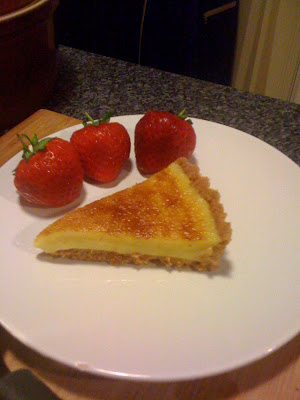It’s been really hot in London this week, so a perfect time to do the first proper recipe from “The French Laundry Cookbook” that I got last weekend. Gazpacho!
I made the balsamic glaze the day before making this and it was really easy, the only thing to keep in mind is to keep the heat very low. I used my diffuser which made it a lot easier but the glaze still started to bubble a bit after 2 hours on the hob so I had to move it to one half of the diffuser to keep the temperature. All in all the cooking of the glaze took about 2,5 hours. After the glaze was done I stored it in a little squeeze bottle in my cupboard.
This soup was truly amazing… bursting with flavours. First you got tomato and cucumber, then the heat from the cayenne and the onions and finally the sweetness from the balsamic glaze.
Perfect for a warm summer night in the beginning of July.
We enjoyed the soup with some bread sprinkled with extra virgin olive oil and then lightly toasted under the grill.
The wine was a kiwi Chardonnay that worked very well with the soup. Since the soup is quite powerful and spicy you need something like a buttery and big (think New World wines) Chardonnay with quite low acidity to match it.
Ingredients for the balsamic glaze:
500 ml balsamic vinegar (I used Aceto Balsamico Di Modena)
Preparing the balsamic glaze:
Heat the vinegar in a heavy saucepan over medium heat until steam rises from the liquid. Place the saucepan on a heat diffuser and let the liquid reduce very slowly (it shouldn’t simmer) for 2 to 3 hours, until it has reduced and thickened to a syrupy glaze. There should be approximately 1/2 cup of glaze. Keep the glaze in a squeeze bottle at room temperature for garnishing: if the glaze is too thick, warm the bottle in hot water to loosen the glaze.
Ingredients for the gazpacho:
240 ml chopped red onions (about 1 medium sized red onion)
240 ml chopped green bell pepper (about 1,5 medium sized green pepper)
240 ml chopped English cucumber (about 1 cucumber)
240 ml chopped and peeled tomatoes (about 4 medium sized tomatoes)
1 1/2 teaspoons chopped garlic (about 2-3 cloves)
1 1/2 teaspoons kosher salt
1/4 teaspoon cayenne
60 ml tomato paste (I couldn’t find tomato paste so I around 2 tablespoons tomato pure instead)
1 tablespoon white wine vinegar
90 ml extra virgin olive oil
1 tablespoon fresh lemon juice
710 ml tomato juice (I used 750 ml because that’s what was in the bottle)
Sprig of thyme
Preparing the gazpacho:
1. Mix all the ingredients except the balsamic glaze together in a bowl or other container, cover, and let sit in the refrigerator overnight.
2. The next day, remove the thyme and blend all the ingredients in a blender until the gazpacho is smooth. You will have about 2 quarts. For a smoother texture, strain the soup to yield about 1 quart. Refrigerate the gazpacho until ready to serve.
To complete: Ladle the cold soup into bowls and squeeze dots of balsamic glaze over the top.





